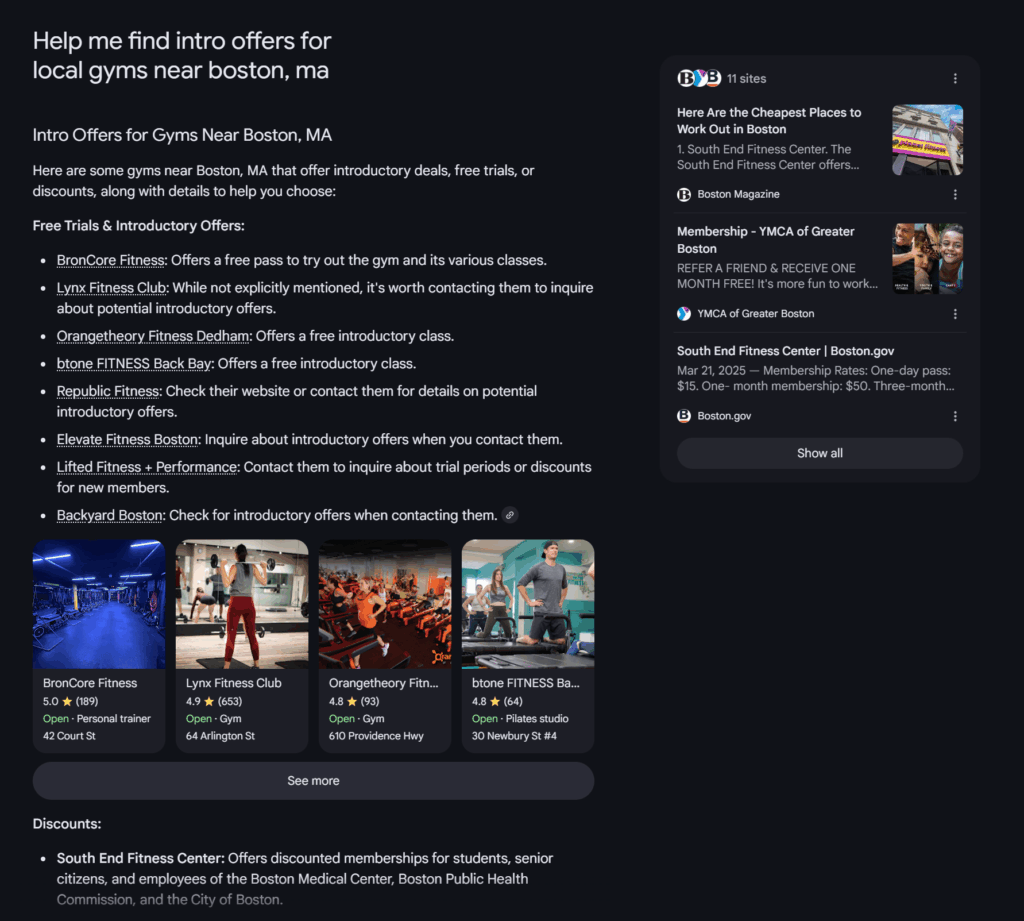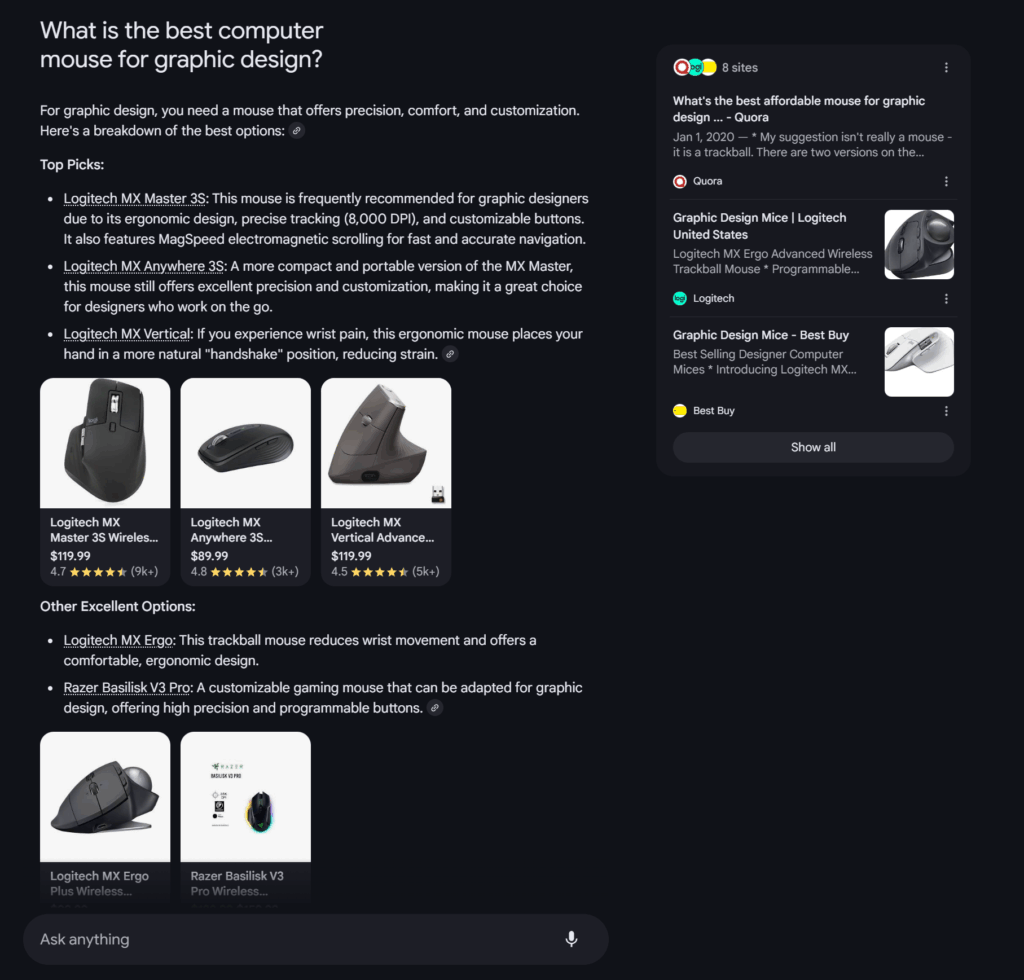Google just changed the way search works.
As of this week, AI Mode is rolling out to users across the U.S. This isn’t a tweak to the algorithm or another round of AI Overviews. It’s an entirely new search experience – one that removes traditional results altogether and replaces them with a fully interactive, generative interface powered by Gemini.
If your business relies on being found through search, this matters. AI Mode changes how people ask questions, how they get answers, and whether they ever see your website at all.
What is AI Mode?
AI Mode is a new version of Google Search that skips the list of blue links and launches users into a chat-style experience instead. Powered by Google’s Gemini model, it gives users a conversational way to explore topics, ask follow-up questions, and get AI-generated answers without ever leaving the interface.
It’s not just about summaries – it’s a complete rethinking of how people search.
And it’s not limited to desktop. On Android devices, Gemini is now built in, letting users trigger AI Mode through voice, screenshots, or the search bar itself. The traditional SERP is no longer the default, especially for more complex searches across Google apps.
That shift has major implications for visibility, traffic, and how your business gets discovered online through this new layer of powerful AI search.
AI Mode SEO Adjustments: Mindset & Strategy
AI Mode doesn’t eliminate SEO. It just changes how it works.
Businesses now need to optimize for two search experiences: the traditional results page and the new AI Mode interface. We’ve been preparing for this shift since the launch of Google’s SGE (now AI Overviews), but with AI Mode now rolling out across the U.S., that shift is live — and it’s reshaping how people engage with content.
Google isn’t just listing links anymore. With AI Mode, it’s summarizing information on your behalf and deciding what makes the cut based on clarity, trust, and structure. (Can anyone say EEAT?)
Here’s what we’re seeing:
- Authoritative, well-structured pages are more likely to be referenced in AI responses. This is where our optimizations for EEAT focused content come in, showcasing Expertise, Experience, Authoritativeness, and Trust. Helpful content that matches intent increases your chances of being included
- Rankings still matter, especially for traditional search, but they’re no longer the whole picture. We’ll be closely watching what percentage of search queries utilize AI Mode over time.
- Click-through rates may decline fruther, even for well-ranked pages as AI Mode pushes users toward a Zero Click experience. But, getting your brand listed in the AI Layer will still get you the eyeballs you are looking for.
- Internal linking, local relevance, and trust signals all influence visibility in the AI layer. Your internal link strategy is more important than ever – using content clusters to further signify authority and trust.
- Structured data (schema) helps Google AI parse and cite your content correctly
- The role of Local SEO is increasing, especially when users are asking location-based questions (more on this in the next section).
The fundamentals of SEO still apply. But the surface area of search has changed. Getting seen now depends on showing up in a layer of results that’s built for summaries, not just clicks.
How AI Mode is Rewriting the Local SEO Playbook
If your business depends on local visibility, this shift isn’t just important — it’s foundational.
Until now, Google AI Overviews occasionally pulled in local references, but never fully leaned into local search. With AI Mode, that’s changing. We’re seeing local business data integrated directly into AI responses — and that data is coming straight from your Google Business Profile (GBP), not your website.
For searches like “furniture store near me” or “kids’ gyms in Dallas,” the AI response often includes a visual card with business name, review rating, hours, and images — all from the GBP. Website links aren’t even listed in the AI Mode results. They are only shown after you first click to a Google Business Profile.
Key shifts we’re seeing:
- Links now point directly to your GBP, not your homepage or location page. While this is only true for the AI Mode results, it shows how truly protected your local rankings are – and indicates the significance of an optimized Google Business Profile.
- Reviews, photos, and hours are shown prominently in the AI snapshot — often before any traditional content.
- Local packs and map results are being reshaped and folded into the AI experience.
For local businesses, this means:
- Your GBP is now your first impression. Optimizing it is no longer optional.
- Strong, recent reviews and detailed listings help boost visibility in AI-generated results.
- Your website still matters. Even if users don’t click through from AI Mode, Google AI continues to rely on your website to validate and support the information shown in your GBP. It plays a critical role in reinforcing your business’s credibility, clarifying your services, and demonstrating topical authority. Pages with strong local content, schema markup, and signals of expertise and trust help strengthen your presence in both AI Mode and traditional search — especially when it comes to content depth and alignment with user intent.
Think of your website as your foundation — but your Google Business Profile as the front door. In AI Mode, that’s what users see first. If it’s not clear, current, and compelling, you’re missing your shot at being chosen (or clicked).
How Trebletree is Responding to Google AI

We’re not just watching this unfold — we’re testing it in real time across our client portfolio.
As AI Mode rolls out, we’re tracking how visibility shifts between traditional rankings and the AI experience, and where users are actually clicking. Spoiler: in many cases, it’s not to the website first
What We’re Monitoring These AI Models
We’re focused on two key areas:
- AI Mode adoption and user behavior
We want to understand how often users are actually engaging with AI Mode versus sticking to traditional search. While Google has rolled out AI Mode broadly, we know not every user embraces it. We’re watching for patterns in usage and adoption across device types, query types, and industries. - Client visibility and performance inside AI Mode
We’re analyzing which of our clients are being cited, how frequently Google Business Profiles are being pulled into AI responses, and whether users are clicking through to the website or stopping within Google’s ecosystem. We’re looking at click paths, branded visibility in generative answers, and how behavior differs from traditional rankings.
We’re also evaluating how our data tools are keeping up. We’re testing how platforms like Conductor, Semrush, and SOCi reflect these shifts — especially when it comes to tracking local visibility and engagement.
UTM tagging on GBP links is also helping us measure how much traffic is now coming through business profiles instead of traditional organic results.
How We’re Adapting to AI Features

- Doubling down on Google Business Profile optimization
We’re treating GBPs like the new front door — with regular audits, strong visuals, keyword-aligned descriptions, local-optimized products and services, and review strategies that support both search visibility and user trust. - Building AI-aware content strategies
We’re prioritizing content that is structured, clear, and useful. FAQs, schema, content clusters, and internal links all help support advanced reasoning and increase the chances of being cited in AI responses – especially within helpful links. - Strengthening technical SEO
From schema markup to crawlability and Core Web Vitals, we’re making sure our clients’ websites are in peak technical shape. Even if users don’t click through as often, Google still relies on the website to validate business information and support topical authority. - Evolving how we measure success
Traditional rank tracking is no longer the full story. We’re layering in metrics like GBP engagement and refining our reports to reflect visibility across both classic and AI-powered search.
As the most powerful AI search experience Google has ever released continues to evolve, we’re making sure our clients are positioned to evolve with it — showing up in the moments that matter, wherever users are searching.
Let’s look at some example searches:
AI Mode isn’t just changing how results look — it’s redefining what types of content get surfaced, and how users interact with search results. Here are a few examples for illustrative purposes – highlighting just how different this experience can be:
From Transactional to Informational
Search: “Make a table comparing memory foam vs hybrid mattresses”
This isn’t just a product search — it’s a request for a structured comparison. And that’s exactly how AI Mode handles it.
Instead of surfacing ecommerce category pages or brand websites, AI Mode delivers a clean, generative table outlining the differences between mattress types: support level, motion isolation, cooling, durability, and more. There are no ads. No product listings. No purchase links. Just the answer — structured, summarized, and fully contained inside the AI interface.
Why this matters: Google is getting better at interpreting user intent — and in this case, it recognized that you wanted a comparison, not a shopping experience. So rather than showing a list of products to buy, it generated the information you asked for.
This doesn’t mean purchase intent is gone. But it does mean Google may satisfy that intent before the user ever reaches your site — and that makes informational clarity just as critical as conversion strategy.
It will be interesting to see how this experience evolves — especially if and when ads are introduced into AI Mode in the future.

A New Kind of Local Search
Search: “Help me find intro offers for local gyms near Boston, MA”
This AI response goes beyond the traditional local pack. It surfaces Google Business Profiles directly in the AI interface — showing details like reviews, hours, and photos — but it also appears to pull additional context from GBP posts and even business websites. For example, mentions of free trial offers, class schedules, or limited-time promotions may be referenced, even if that information isn’t listed explicitly in the GBP.
The result is a more nuanced, AI-assembled view of the business that combines local listing data with on-site content to better match the query intent.
Impact: It’s no longer enough to just rank in the local pack. Google is building composite responses that blend structured GBP data with signals from your website. Intro offers, services, and class info need to exist in both places — and match. This is about consistency and completeness across platforms, with your GBP and website working together to create a unified brand profile inside AI Mode.

Ecommerce in the AI Experience
Search: “What is the best computer mouse for graphic design?”
Here, AI Mode brings in Google Shopping results — not in a sidebar or a list of links, but as part of the AI-generated answer. Visual product cards appear with names, pricing, and sellers, all sourced through Google’s product feed integrations.
Impact: Brands relying on ecommerce visibility need to ensure product feeds, merchant listings, and schema are clean and structured to get pulled into this experience.

What This AI Shift Means for Your Business
Google didn’t flip a switch overnight. It’s been nudging us toward this moment – first with AI Overviews not so subtly changing how users interact with search. Now, with AI Mode rolling out across the U.S., those gradual shifts are turning into a very real change in how your business shows up online.
But let’s be clear: AI Mode isn’t the default — yet. Users still need to click to enter this experience. That means adoption will vary, and we’re watching closely to see who uses it, how often, and for what types of searches.
So… is it time to say SEO is dead? Again?
Not yet! But, SEO is changing fast.
Instead of competing for a list of links, you’re now competing to be part of the answer itself. Google is pulling from your Google Business Profile, your website, your product feeds, and your structured content – and deciding what’s accurate, helpful, and complete enough to include in its AI-powered results.
In many ways, this is what Google’s been pushing us toward for years: EEAT. Helpful content. Topical authority. Structured data.
The same foundational elements of good SEO now fuel the visibility layer inside AI Mode – whether users are searching via desktop, mobile, or integrated Google apps like Gemini.
We don’t know exactly how this experience will evolve — or when ads will become part of it — but we do know this: the businesses that adapt early will have a serious advantage. Visibility isn’t gone. But how you earn it is changing.

